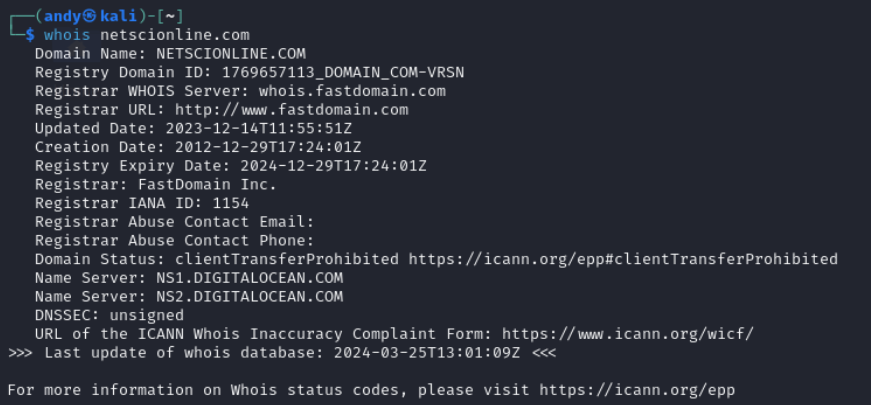The whois command is a tool commonly used on various operating systems, including Linux, MacOS, and Windows, to query databases that store the registered users or assignees of an Internet resource, such as a domain name, an IP address block, or an autonomous system. It can provide information such as the domain owner, contact information, domain registration and expiration date, and the nameservers it’s using. Here is an example (output is truncated):

Here’s a basic guide on how to use the whois command:
1. Opening Terminal or Command Prompt
- Linux/MacOS: Open the Terminal.
- Windows: Open Command Prompt or PowerShell.
2. Using the Command
The basic syntax for the whois command is as follows:
whois [options] domain_name- Replace
domain_namewith the domain or IP address you’re inquiring about. [options]can be used to specify various flags that modify the command’s behavior, although for most users, the basic command without options is sufficient.
3. Examples
- To find information about a specific domain: w
hois example.com - To query a specific WHOIS server (if you know the server that holds the record):
whois -h whois.servername.net example.comReplacewhois.servername.netwith the actual server name. - For IPv4 or IPv6 addresses, the usage is similar:
whois 192.0.2.1orarduinoCopy codewhois 2001:db8::1
4. Interpreting Results
The output can be extensive, including:
- Registrant contact information (may be redacted for privacy).
- Registrar information (where the domain was registered).
- Domain registration and expiration dates.
- DNS information.
- Status of the domain.
5. Privacy and Restrictions
- Due to privacy laws and policies, such as GDPR in Europe, some personal information might be redacted.
- Some registries rate limit whois requests to prevent abuse.
6. Installation
- Linux: Most Linux distributions come with
whoispre-installed. If not, it can be installed via your package manager (e.g.,apt-get install whoison Debian/Ubuntu). - MacOS:
whoisis usually pre-installed. If it’s missing, you can install it using Homebrew (brew install whois). - Windows:
whoisis not built-in, but you can use third-party tools or download it from internet resources that provide Windows-compatible versions.
This is a general guide; specific options and outputs might vary based on the operating system and the version of the whois tool you are using. Always refer to the manual or help command (man whois or whois --help) for the most accurate and detailed information.
The whois command is a versatile tool that serves several important use cases across different domains, including cybersecurity, digital forensics, legal research, and domain management. Here are some of the key use cases for the whois command:
1. Domain Ownership Verification
- Verifying the owner of a domain to ensure its legitimacy or to identify the entity behind a website. This is particularly useful in determining if a site is potentially fraudulent or trustworthy.
2. Contacting Domain Owners
- Finding contact information for a domain owner. This can be important for a variety of reasons, including negotiating domain purchases, reporting security vulnerabilities, or legal purposes.
3. Cybersecurity and Investigation
- Tracking malicious activity: Security professionals can use
whoisto gather information about domains involved in phishing, malware distribution, or other malicious activities. This information can help trace the origin of attacks and identify attackers. - Investigating spam: Identifying the registrants of domains sending spam emails can help in blocking or reporting these domains.
4. Intellectual Property and Legal Research
- Trademark enforcement: Companies can use
whoisto find domains that may be infringing on their trademarks, allowing them to take legal action or contact the domain owner for resolution. - Legal investigations: In cases of cybercrime, lawyers and legal researchers can use
whoisdata as part of the evidence-gathering process to establish ownership of domain names involved in illegal activities.
5. Domain Research and Acquisition
- Researching domain availability: Before registering a new domain,
whoiscan be used to check if a domain is already taken, and if so, when it might expire. - Acquiring expired domains: Investors and companies interested in purchasing existing domains can use
whoisto find out when a domain’s registration is due to expire and prepare to acquire it.
6. Network Administration and Troubleshooting
- Identifying IP allocations: Network administrators can use
whoisto identify how IP address blocks are allocated and to which organizations they are assigned. - Troubleshooting network issues:
whoiscan help determine the administrative contact for an IP address or domain, which can be useful in resolving network routing problems or abuse issues.
7. Market Research and Competitor Analysis
- Analyzing competitors: Businesses can use
whoisto identify new or existing domains registered by competitors, providing insights into competitors’ online strategies and potential new ventures.
8. Reporting Abuse
- Identifying contacts for reporting abuse:
whoisprovides contact information for reporting illegal activities, security vulnerabilities, or terms of service violations associated with a domain.
The whois command, while simple, plays a crucial role in a wide range of online and network-related activities, offering valuable insights into the ownership and administration of internet resources.
Comments are welcomed below from registered users. If you would like to see more content and articles like this, please support us by clicking the patron link where you will receive free bonus access to courses and more, or simply buying us a cup of coffee!
